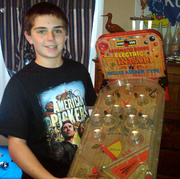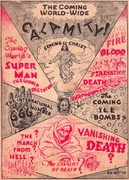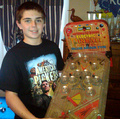Today’s guest blogger is artist, author, and collector Jim Linderman, who treats his blog like an art form. You can find him on Show & Tell, too.
Matchbooks are certainly one of the most-collected paper ephemera items. Even as smoking declines, the book of matches remains as common as a coin and familiar as a photo. Far less common, however, are the matchboxes—the wooden, sliding cases which held stick matches. Approaching extinction today (except in upscale hotels and bars) wooden matchboxes were created in quantities rivaling postage stamps, and there is an active group of collectors today seeking scarce examples.
 “Phillumenists” collect matchbooks, and “phillumeny” is the term for the hobby. I suppose every phillumenist started out playing with matches. Exciting, magical, taboo, and punishable sticks of fire. Father would leave a pack on the couch armrest, and there would soon be smoke in the backyard. Every boy goes through it, but it isn’t until Cub Scout campfires he is allowed to carry them with permission. I do not know if any matchbox collectors have been proven to be responsible for starting wildfires.
“Phillumenists” collect matchbooks, and “phillumeny” is the term for the hobby. I suppose every phillumenist started out playing with matches. Exciting, magical, taboo, and punishable sticks of fire. Father would leave a pack on the couch armrest, and there would soon be smoke in the backyard. Every boy goes through it, but it isn’t until Cub Scout campfires he is allowed to carry them with permission. I do not know if any matchbox collectors have been proven to be responsible for starting wildfires.
Who knows what influences a collector? Maybe every time a parent yells, “That’s sharp!” a knife collector is born.
 It makes sense the Chinese invented matches, as they have generally been credited with many things pyrotechnic. They called them “light-bringing slaves” or “fire-inch sticks” which were basically sulfer gobs on wood. Today, they are most often known as “safety” matches. “Impregnated” is the term used for a match stick which has been treated with chemicals to prevent afterglow, you will see the term proudly displayed on many boxes.
It makes sense the Chinese invented matches, as they have generally been credited with many things pyrotechnic. They called them “light-bringing slaves” or “fire-inch sticks” which were basically sulfer gobs on wood. Today, they are most often known as “safety” matches. “Impregnated” is the term used for a match stick which has been treated with chemicals to prevent afterglow, you will see the term proudly displayed on many boxes.
Of course, it is the graphics, the scarcity, and the condition which drives collectors today. If I were a collector, I would likely have better examples to show here, but all mine came at once … in a wonderful, primitive scrapbook of one Lowell E. Root.
Lowell collected around 100 examples and glued them into his book in 1926, he took the time to date it. One page is shown … Lowell carefully numbered each example, a splendid group, which he probably begged from his traveling relatives and neighborhood friends.
Every young boy should have a collection. Lowell seems to have chosen a striking one!



 Garbage Pile Kids: Five Young Collectors Who Dig Rust, Dust, and Old Tobacco
Garbage Pile Kids: Five Young Collectors Who Dig Rust, Dust, and Old Tobacco
 Playing With Matches: Sexy, Silly 1930s Ads That Went Up in Smoke
Playing With Matches: Sexy, Silly 1930s Ads That Went Up in Smoke Garbage Pile Kids: Five Young Collectors Who Dig Rust, Dust, and Old Tobacco
Garbage Pile Kids: Five Young Collectors Who Dig Rust, Dust, and Old Tobacco Hellfire and Damnation in Your Back Pocket
Hellfire and Damnation in Your Back Pocket Match HoldersMatch holders, also known as matchsafes or vesta cases, date to the mid-19t…
Match HoldersMatch holders, also known as matchsafes or vesta cases, date to the mid-19t… MatchbooksMatchbooks have been around since 1892, when Joshua Pusey patented the idea…
MatchbooksMatchbooks have been around since 1892, when Joshua Pusey patented the idea… Mari Tepper: Laying it on the Line
Mari Tepper: Laying it on the Line Nice Ice: Valerie Hammond on the Genteel Charm of Vintage Canadian Costume Jewelry
Nice Ice: Valerie Hammond on the Genteel Charm of Vintage Canadian Costume Jewelry How Jim Heimann Got Crazy for California Architecture
How Jim Heimann Got Crazy for California Architecture Modernist Man: Jock Peters May Be the Most Influential Architect You've Never Heard Of
Modernist Man: Jock Peters May Be the Most Influential Architect You've Never Heard Of Meet Cute: Were Kokeshi Dolls the Models for Hello Kitty, Pokemon, and Be@rbrick?
Meet Cute: Were Kokeshi Dolls the Models for Hello Kitty, Pokemon, and Be@rbrick? When the King of Comedy Posters Set His Surreal Sights on the World of Rock 'n' Roll
When the King of Comedy Posters Set His Surreal Sights on the World of Rock 'n' Roll How One Artist Makes New Art From Old Coloring Books and Found Photos
How One Artist Makes New Art From Old Coloring Books and Found Photos Say Cheese! How Bad Photography Has Changed Our Definition of Good Pictures
Say Cheese! How Bad Photography Has Changed Our Definition of Good Pictures Middle Earthenware: One Family's Quest to Reclaim Its Place in British Pottery History
Middle Earthenware: One Family's Quest to Reclaim Its Place in British Pottery History Fancy Fowl: How an Evil Sea Captain and a Beloved Queen Made the World Crave KFC
Fancy Fowl: How an Evil Sea Captain and a Beloved Queen Made the World Crave KFC
i’m getting ready to display an old collection of matchbooks we’ve had for 50 yrs. should i cut out the matches? will that hurt the value? Thanks for any information you can give me.
I recently found a Diamond 2¢ matchbox, which belonged to my dearest grandmother. I have an odd collection, but all priceless to me. I can’t find any straight answers about it, mainly when printed…it states 34 matches, there are 19 remaining. If you could help:) thanks
I also have some of the above matchboxlabels in my collection.
I´m from Denmark and have been collecting matchboxlabels, -skillet & -covers since the 1960s.
My collection contents now more than 134,000 different items from 171 countries around the world.
Please feel free to watch a part of my worldwide collection here: http://www.phillumeny.dk
In vintage movies you very often see people striking their matches on anything and everything after which they always flame up…even when they strike it on their britches leg or by their thumbnail. My question is were those antique matches from yesteryear made different from todays? The matches we now have will not strike on anything but the place on the box or pack made just for that purpose. Matches apparantly lit very, very easly then. Why?